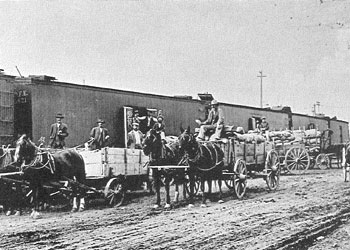 Hauling the biggest load of potatoes to town was a feat.
Hauling the biggest load of potatoes to town was a feat.
One of the most important characteristics of the Act was that it required reclamation by irrigation, occupation, and cultivation before a patent would be issued-unless as provided by the 1896 amendment, sufficient water was available in substantial ditches or reservoirs to reclaim the lands.
One of the fullest descriptions of the developments and consequences of the Carey Act in Idaho was written as a special report by Mikel H. Williams, a Research Assistant with the Idaho Department of Reclamation, in 1970. His very extensive and complete study of the effects of the Carey Act nationally and his thorough investigation of each project in Idaho provides a great deal of information and insight into the history of irrigation in Idaho.
Over a period of 40 years, 64 Carey proposals were filed with the State Land Board of Idaho. The determination of the success or failure of the Carey Act in Idaho is difficult to generalize about for there are many factors to be considered. Of great importance was the fact that the state of Idaho received 618,000 acres of previously desert, arid land. But, the overall benefit from the construction of dams and canals, the settlement of farms, the birth of towns and cities, and the production of crops on the economy of Idaho is impossible to measure.
The problems Idaho had with the Carey Act stem from two sources, according to Williams: the cost of financing a project and after a project was completed, of supplying the land with adequate water for reclamation. A review of Idaho's 64 projects illustrates that almost every project exceeded the estimated cost of construction. In fact, the general rule was that the final cost was double the original estimate.
After a substantial number of failures of construction companies, it became increasingly difficult to finance a Carey project or to complete those already under construction. In the early 1900s, the problem became so acute that it was almost impossible to sell bonds to the general public or to find people willing to invest as stockholders in a construction company. As more companies failed, less investors could be found, and being unable to secure additional funds to complete the projects already underway, more companies went bankrupt or had their contracts with the State of Idaho forfeited. This caused the general public to become even more wary of investing its money in any type of Carey Act undertaking.


 Hauling the biggest load of potatoes to town was a feat.
Hauling the biggest load of potatoes to town was a feat.